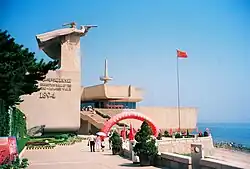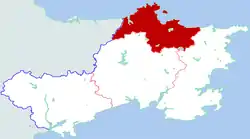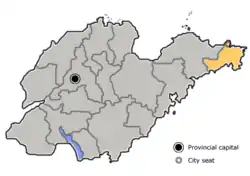Huancui District
Huancui (simplified Chinese: 环翠; traditional Chinese: 環翠; pinyin: Huáncuì) is a district and the seat of the city of Weihai, Shandong province, China.
Huancui
环翠区 | |
|---|---|
 Monument commemorating the First Sino-Japanese War on Liugong Island | |
 Huancui in Weihai | |
 Weihai in Shandong | |
| Coordinates (Huancui government): 37°30′07″N 122°07′23″E | |
| Country | People's Republic of China |
| Province | Shandong |
| Prefecture-level city | Weihai |
| Area | |
| • Total | 991 km2 (383 sq mi) |
| Population (2019)[1] | |
| • Total | 368,500 |
| • Density | 370/km2 (960/sq mi) |
| Time zone | UTC+8 (China Standard) |
| Postal code | 264200 |
| Website | www |
History
In 1398, the Hongwu Emperor launched an initiative to counteract raiding wokou, which involved sending imperial troops to the area of present-day Huancui to defend the coast.[2]
The city of Weihaiwei and nearby Liugong Island were forcibly leased to British forces from 1898 to 1930 as British Weihaiwei.[2]
The area was liberated from Japanese forces in August 1945.[2]
On June 15, 1987, Weihai was expanded from a county-level city to a prefecture-level city, and the area of the county-level city became contemporary Huancui District.[2]
Geography
Huancui District is relatively low in elevation, with only a few peaks rising above 500 metres (1,600 ft) in height.[3] The district's southern edge lies along the eastern portion of the Jiaolai Plains.[3]
Climate
The district has a continental climate, with four seasons and relatively moderate temperatures.[3] The district experiences an average annual temperature of 12 °C (54 °F), an average annual precipitation of 737.7 millimetres (29.04 in), and 2,480.0 average hours of sunshine per year.[3]
Administrative divisions
As of 2020, Huancui District is divided to five subdistricts and three towns.[2][4] These township-level divisions are then divided into 102 residential communities and 62 administrative villages.[2]
Economy
Huancui District recorded a gross domestic product of ¥37.603 billion in 2019, which grew at an annual increase of 3.2%.[5] The district's primary sector shrunk 1.1% in 2019, accounting for ¥3.028 billion, or 8.1% of the economy.[5] The district's secondary sector grew 5.0% in 2019, accounting for ¥12.076 billion, or 32.1% of the economy.[5] The district's tertiary sector grew 2.6% in 2019, accounting for ¥22.499 billion, or 59.8% of the economy.[5] The district's official urban unemployment rate in 2019 was 0.67%.[5]
Aquaculture
As of 2019, Huancui District has the largest aquaculture sector in Weihai, and the sector grew 10.7% that year.[5] In 2019, the district's aquaculture sector attracted ¥3.173 billion of investment, and the district government began a collaboration with Shandong University's Weihai Campus to promote industry research in the district.[5]
Foreign trade
The district conducts a significant amount of foreign trade, totaling ¥21.57 billion in 2019.[5] Of this, 15.75 ¥billion was in exports, and ¥5.82 billion was in imports.[5] In 2019, 18.4% of the district's exports were to South Korea, 17.9% went to the European Union, 17.3% went to Japan, 13.1% went to the United States, and the remaining 33.3% went to other trading partners.[5] 43.1% of the district's exports in 2019 were textiles and apparel, 18.0% of the district's exports were electronics and machinery, 5.5% of the district's exports were agricultural goods, and the remaining 33.4% of exports were in other sectors.[5]
References
- 最新人口信息 www.hongheiku.com (in Chinese). hongheiku. Retrieved 2021-01-12.
- 建制区划 (in Chinese). Huancui District, Weihai People's Government. 2020-05-27. Archived from the original on 2021-01-09. Retrieved 2021-01-09.
- 自然环境 (in Chinese). Huancui District, Weihai's People's Government. 2020-05-27. Archived from the original on 2021-01-09. Retrieved 2021-01-09.
- 2020年统计用区划代码(环翠区) (in Chinese). National Bureau of Statistics of China. 2020. Archived from the original on 2021-01-09. Retrieved 2021-01-09.
- 经济发展 (in Chinese). Huancui District, Weihai People's Government. 2020-05-27. Archived from the original on 2021-01-09. Retrieved 2021-01-09.
External links
- (in Chinese) Weihai Huancui Government website